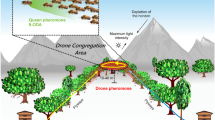Summary
The effects of dopamine applied to the antennal lobes of the honeybee are investigated using the proboscis conditioning paradigm (Kuwabara 1957). The percentage of bees responding to a conditioned olfactory stimulus after a single conditioning trial is reduced significantly by the application of dopamine (10−6 M) to the antennal lobes of the bee brain. Reduction in response levels is significantly smaller in bees conditioned to the olfactory stimulus in multiple conditioning trials prior to treatment with dopamine. The effects of dopamine on the percentage of bees responding to a conditioned olfactory stimulus are blocked by the butyrophenone, haloperidol (10−5 M). The possible role of dopaminergic interneurones in the antennal lobes of the bee brain is discussed.
Access this article
We’re sorry, something doesn't seem to be working properly.
Please try refreshing the page. If that doesn't work, please contact support so we can address the problem.
Similar content being viewed by others
References
Boeckh J (1974) Die Reaktionen olfaktorischer Neurone im Deutocerebrum von Insekten im Vergleich zu den Antwortmustern der Geruchssinneszellen. J Comp Physiol 90:183–205
Boeckh J, Ernst KD, Sass H, Waldow U (1984) Anatomical and physiological characteristics of individual neurones in the central antennal pathway of insects. J Insect Physiol 30:15–26
Burrows M, Boeckh J, Esslen J (1982) Physiological and morphological properties of interneurones in the deutocerebrum of male cockroaches which respond to female pheromone. J Comp Physiol 145:447–457
Erber J (1975a) The dynamics of learning in the honeybee (Apis mellifica carnica). I. The time dependence of the choice reaction. J Comp Physiol 99:231–242
Erber J (1975b) The dynamics of learning in the honeybee (Apis mellifica carnica). II. Principles of information processing. J Comp Physiol 99:243–255
Erber J (1976) Retrograde amnesia in honeybees (Apis mellifera carnica). J Comp Physiol Psychol 90:41–46
Homberg U (1984) Processing of antennal information in extrinsic mushroom body neurons of the bee brain. J Comp Physiol A 154:825–836
Jawlowski H (1957) Nerve tracts in bee (Apis mellifica) running from the light and antennal organs to the brain. Annales Univ. Mariae Curie-Sklodowska Lublin (D). X11/22:307–323
Klemm N (1974) Vergleichend-histochemische Untersuchungen über die Verteilung monoamin-haltiger Strukturen im Oberschlundganglion von Angehörigen verschiedener Insektenordnungen. Entomol Germ 1:21–49
Klemm N (1976) Histochemistry of putative transmitter substances in the insect brain. Prog Neurobiol 7:99–169
Kuwabara M (1957) Bildung des bedingten Reflexes von Pavlovs Typus bei der Honigbiene,Apis mellifica. J Fac Sci Hokkaido Univ (Ser 6) 13:458–464
Martin H (1964) Zur Nahorientierung der Biene im Duftfeld. Zugleich ein Nachweis für die Osmotropotaxis bei Insekten. Z Vergl Physiol 48:481–533
Martin H (1965) Leistungen des topochemischen Sinnes bei der Honigbiene. Z Vergl Physiol 50:254–292
Masson C (1982) Basic mechanisms of sensory antennal information processing in insects, with special reference to social insects. In: Breed MD, Michener CD, Evans HE (eds) The biology of social insects. Westview Press, Boulder, Colorado, pp 380–384
Masuhr T, Menzel R (1972) Learning experiments on the use of side-specific information in the olfactory and visual system in the honeybee (Apis mellifica). In: Wehner R (ed) Information processing in the visual systems of arthropods. Springer, Berlin Heidelberg New York, pp 315–321
Matsumoto SG, Hildebrand JG (1981) Olfactory mechanisms in the mothManduca sexta: response characteristics and morphology of central neurons in the antennal lobes. Proc R Soc Lond B 213:249–277
Menzel R, Erber J (1978) Learning and memory in bees. Sci Am 239:80–87
Mercer AR (1986) Biogenic amines in the insect brain. In: Gupta AP (ed) Arthropod brain: its evolution, structure and functions. Wiley & Sons, New York, in press
Mercer AR, Menzel R (1982) The effects of biogenic amines on conditioned and unconditioned responses to olfactory stimuli in the honeybeeApis mellifera. J Comp Physiol 145:363–368
Mercer AR, Mobbs PG, Davenport AP, Evans PD (1983) Biogenic amines in the brain of the honeybee,Apis mellifera. Cell Tissue Res 234:655–677
Mobbs PG (1982) The brain of the beeApis mellifera. I. The connections and spatial organisation of the mushroom bodies. Philos Trans R Soc Lond B 298:309–354
Mobbs PG (1984) Neural networks in the mushroom bodies of the honeybee. J Insect Physiol 30:43–58
Mobbs PG (1985) Brain structure. In: Kerkut GA, Gilbert LI (eds) Comprehensive insect physiology, biochemistry and pharmacology, vol 5. Nervous system, structure and motor function. Pergamon Press, Oxford, pp 299–370
Pareto A (1972) Die zentrale Verteilung der Fühlerafferenz bei Arbeiterinnen der Honigbiene,Apis mellifera L. Z Zellforsch Mikrosk Anat 131:109–140
Pinching AJ, Powell TPS (1971) The neuropil of the glomeruli of the olfactory bulb. J Cell Sci 9:347–377
Rall W, Shepherd GM, Reese TS, Brightman MW (1966) Dendrodendritic synaptic pathway for inhibition in the olfactory bulb. Exp Neurol 14:44–56
Schäfer S, Bicker G (1986) Distribution of GABA-like immunoreactivity in the brain of the honeybee. J Comp Neurol 246:287–300
Shepherd GM (1971) Physiological evidence for dendrodendritic synaptic interactions in the rabbit's olfactory glomerulus. Brain Res 32:212–217
Shepherd GM (1972) Synaptic organization of the mammalian olfactory bulb. Physiol Rev 52:864–917
Suzuki H (1975) Antennal movements induced by odour and central projection of the antennal neurons in the honeybee. J Insect Physiol 21:831–847
Yamada M (1971) A search for odor encoding in the olfactory lobe. J Physiol (Lond) 214:127–143
Author information
Authors and Affiliations
Rights and permissions
About this article
Cite this article
Macmillan, C.S., Mercer, A.R. An investigation of the role of dopamine in the antennal lobes of the honeybee,Apis mellifera . J. Comp. Physiol. 160, 359–366 (1987). https://doi.org/10.1007/BF00613025
Accepted:
Issue Date:
DOI: https://doi.org/10.1007/BF00613025




